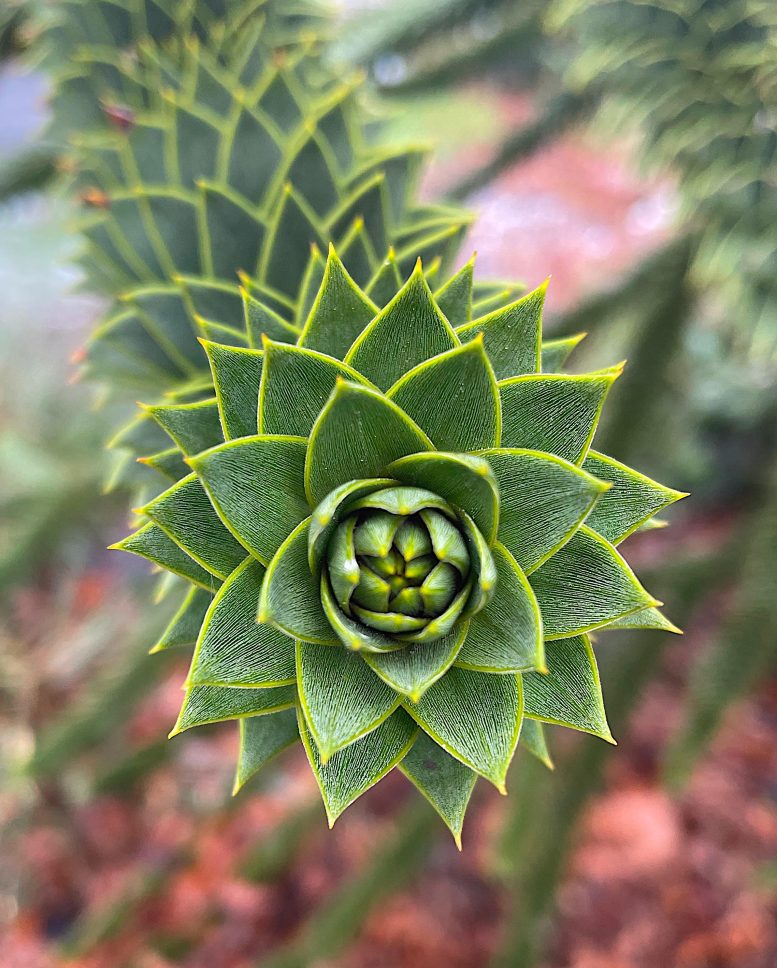
Leaves of a monkey puzzle tree showing Fibonacci spirals. Credit: Photograph taken by Dr. Sandy Hetherington.
A 3D model of a 407-million-year-old plant fossil has reshaped our understanding of leaf evolution. This study has also provided new perspectives on the remarkable patterns observed in plants.
Early plant leaf arrangements differ from those in many contemporary plants, challenging a longstanding belief about the beginnings of a famous mathematical pattern observed in nature, according to recent studies. The results suggest that the typical spiral configurations of leaves seen in nature now were not prevalent in the earliest terrestrial plants that first appeared on our planet.
Instead, the ancient plants were found to have another type of spiral. This negates a long-held theory about the evolution of plant leaf spirals, indicating that they evolved down two separate evolutionary paths. Whether it is the vast swirl of a hurricane or the intricate spirals of the DNA double-helix, spirals are common in nature and most can be described by the famous mathematical series the Fibonacci sequence.
Named after the Italian mathematician, Leonardo Fibonacci, this sequence forms the basis of many of nature’s most efficient and stunning patterns. Spirals are common in plants, with Fibonacci spirals making up over 90% of the spirals. Sunflower heads, pinecones, pineapples, and succulent houseplants all include these distinctive spirals in their flower petals, leaves, or seeds.
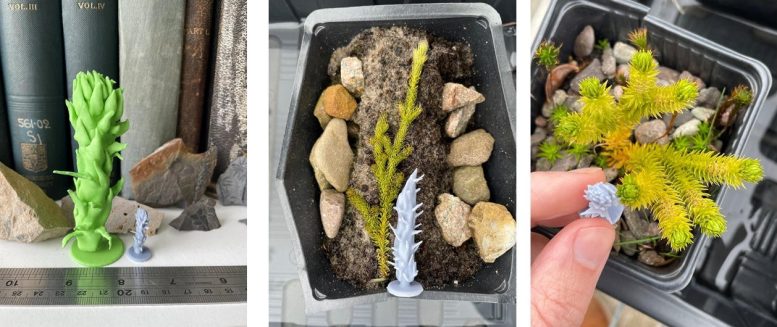
3D-printed fossil stems placed next to living lycophytes. Credit: Dr. Sandy Hetherington
Why Fibonacci spirals, also known as nature’s secret code, are so common in plants has perplexed scientists for centuries, but their evolutionary origin has been largely overlooked.
Based on their widespread distribution it has long been assumed that Fibonacci spirals were an ancient feature that evolved in the earliest land plants and became highly conserved in plants. However, an international team led by the University of Edinburgh has overthrown this theory with the discovery of non-Fibonacci spirals in a 407-million-year-old plant fossil.
Using digital reconstruction techniques the researchers produced the first 3D models of leafy shoots in the fossil clubmoss Asteroxylon mackiei – a member of the earliest group of leafy plants.
The exceptionally preserved fossil was found in the famous fossil site the Rhynie chert, a Scottish sedimentary deposit near the Aberdeenshire village of Rhynie. The site contains evidence of some of the planet’s earliest ecosystems – when land plants first evolved and gradually started to cover the earth’s rocky surface making it habitable.
The findings revealed that leaves and reproductive structures in Asteroxylon mackiei, were most commonly arranged in non-Fibonacci spirals that are rare in plants today.
This transforms scientists’ understanding of Fibonacci spirals in land plants. It indicates that non-Fibonacci spirals were common in ancient clubmosses and that the evolution of leaf spirals diverged into two separate paths. The leaves of ancient clubmosses had an entirely distinct evolutionary history from the other major groups of plants today such as ferns, conifers, and flowering plants.
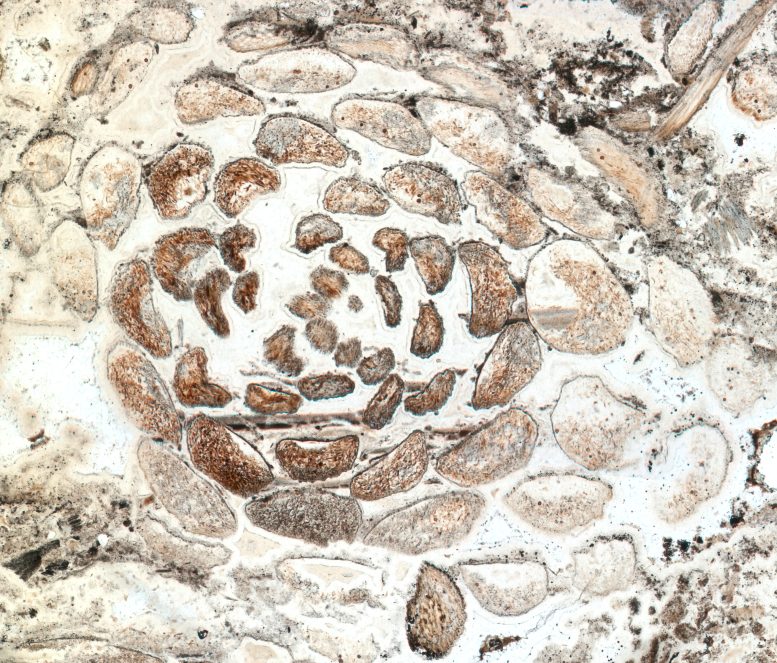
Spiral-arranged leaves can be identified at the shoot tip of the fossil Asteroxylon mackiei. Fossil thin section number GLAHM Kid 2554 in the collections of The Hunterian, University of Glasgow. Credit: Photograph taken by Sandy Hetherington. Specimen number GLAHM Kid 2554 in the collections of The Hunterian, University of Glasgow
The team created the 3D model of Asteroxylon mackiei, which has been extinct for over 400 million years, by working with digital artist Matt Humpage, using digital rendering and 3D printing.
The study also involved researchers from, University College Cork, Ireland, University Münster, Germany and Northern Rogue Studios, UK.
Dr Sandy Hetherington, an evolutionary palaeobiologist and the project’s lead at the University of Edinburgh, said: “Our model of Asteroxylon mackiei lets us examine leaf arrangement in 3D for the first time. The technology to 3D print a 407-million-year-old plant fossils and hold it in your hand is really incredible. Our findings give a new perspective on the evolution of Fibonacci spirals in plants.”
Holly-Anne Turner, who worked on the project as an undergraduate student at the University of Edinburgh and is first author of the study, said: “The clubmoss Asteroxylon mackiei is one of the earliest examples of a plant with leaves in the fossil record. Using these reconstructions we have been able to track individual spirals of leaves around the stems of these 407 million-year-old fossil plants. Our analysis of leaf arrangement in Asteroxylon shows that very early clubmosses developed non-Fibonacci spiral patterns.”
Reference: “Leaves and sporangia developed in rare non-Fibonacci spirals in early leafy plants” by Holly-Anne Turner, Matthew Humpage, Hans Kerp and Alexander J. Hetherington, 15 June 2023, Science.
DOI: 10.1126/science.adg4014
The study was funded by UK Research and Innovation (UKRI), The Royal Society, and the German Research Foundation.

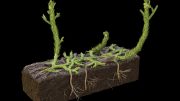


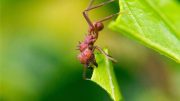

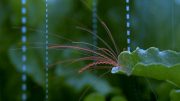


It’s difficult to get excited about this report when there’s no explanation of what constitutes a Fibonacchi spiral, or a non-Fibonacchi spiral, or why either is important in plant leaf position.
The article ignores the fact that the Fibonacci ratio exist not only in plants, but the spiral of animal horns, crystallin structures, the spiral of the our Milky Way galaxy, and the ration of paintings, buildings, and postcards that are pleasing to the eye.
The asteroxylon mackiei fossils were from a Scottish deposit. Maybe it’s just that the Scottish suck at counting. They couldn’t do a Fibonacci spiral if their lives depended on it.
Interesting article.
And there is Fibonacci fervour in Linear Algebra and Quantum Information Theory as well.
The difficulty with this “analysis” is that it assumes that the structure of these plants was preserved precisely in the fossil record. What evidence do the authors present to substantiate their claims?